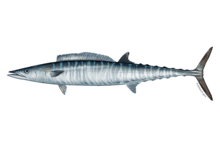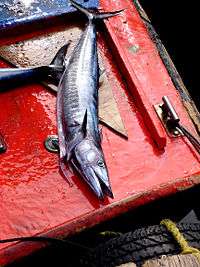Wahoo
Wahoo (Acanthocybium solandri) is a scombrid fish found worldwide in tropical and subtropical seas. It is best known to sports fishermen, as its speed and high-quality flesh makes it a prized game fish. In Hawaii, the wahoo is known as ono.[4]
| Wahoo | |
|---|---|
 | |
| A Wahoo | |
| Scientific classification | |
| Kingdom: | Animalia |
| Phylum: | Chordata |
| Class: | Actinopterygii |
| Order: | Scombriformes |
| Family: | Scombridae |
| Tribe: | Scomberomorini |
| Genus: | Acanthocybium Gill, 1862 |
| Species: | A. solandri |
| Binomial name | |
| Acanthocybium solandri | |
| Synonyms[3] | |
The flesh of the wahoo is white to grey, delicate to dense, and highly regarded by many cuisines. The taste has been said to be similar to mackerel.[5] This has created some demand for the wahoo as a premium-priced commercial food fish. In many areas of its range, such as Hawaii, Bermuda, and many parts of the Caribbean, local demand for the wahoo is met by artisanal commercial fishermen who take them primarily by trolling. Recreational sports fishermen also sell their catch. The wahoo, which is popularly called hoo in the US, is successfully fished with live bait around deep-water oil and gas platforms in the Gulf of Mexico during the winter months.[6]
Description
Its body is elongated and covered with small, scarcely visible scales; the back is an iridescent blue, while the sides are silvery with a pattern of irregular vertical blue bars. These colors fade rapidly during death. The mouth is large, and the teeth of the wahoo are razor sharp. Both the upper and lower jaws have a somewhat sharper appearance than those of king or Spanish mackerel.
Specimens have been recorded at up to 2.5 m (8 ft 2 in) in length, and weighing up to 83 kg (183 lb).[3][7] Growth can be rapid.[7] They are among the fastest fish in the sea.
The wahoo may be distinguished from the related Atlantic king mackerel and from the Indo-Pacific narrow-barred Spanish mackerel by a fold of skin which covers the mandible when its mouth is closed. In contrast, the mandible of the king mackerel is always visible as it is also the case for the smaller Spanish mackerel and Cero mackerel. The teeth of the wahoo are similar to those of king mackerel, but shorter and more closely set together.
The barracuda is sometimes confused with the mackerel and wahoo, but it is easy to distinguish from the latter two species. Barracuda have prominent scales, larger, dagger-like teeth, and lack the caudal keels and blade-like (forked) tail characteristic of the scombrids.
Biology
Wahoo tend to be solitary[8] or occur in loose-knit groups of two or three fish.[9] Where conditions are suitable, they can be found in schools as large as 100 or more. Their diet is made up of other fish and squid.[7]
Most wahoo taken from waters have a trematode parasite, the giant stomach worm (Hirudinella ventricosa), living in their stomachs, but it does not appear to harm the fish.[10][11]
Fisheries
Commercial
Although local wahoo populations can be affected by heavy commercial and sports fishing pressure, wahoo as a species are less susceptible to industrial commercial fishing than more tightly schooling and abundant species such as tuna. Wahoo are regularly taken as a bycatch in various commercial fisheries, including longline fisheries for tuna, billfish, and dolphinfish (mahi-mahi or dorado). It is also taken in tuna purse seine fisheries, especially in sets made around floating objects which act as a focal point for a great deal of other marine life besides tuna. In 2003, the South Atlantic Fishery Management Council issued a Dolphin Wahoo Fishery Management Plan for the Atlantic.[12][13] However, the species as a whole is not considered overfished.[12]
Recreational

In most parts of its range, the wahoo is a highly prized sport fishing catch.[8] It reaches a good size, and is often available not too far from land; it is also a very good fighter on light to medium tackle. It is known in sports fishing circles for the speed and strength of its first run.
References
- Collette, B.; Acero, A.; Amorim, A.F.; et al. (2011). "Acanthocybium solandri". IUCN Red List of Threatened Species. 2011: e.T170331A6750961. doi:10.2305/IUCN.UK.2011-2.RLTS.T170331A6750961.en.CS1 maint: multiple names: authors list (link)
- Cuvier G. & Valenciennes A. (January 1832). Histoire naturelle des poissons. Tome huitième. Livre neuvième. Des Scombéroïdes. Historie naturelle des poissons. v. 8: i-xix + 5 pp. + 1-509, Pls. 209-245. [Cuvier authored pp. 1-470; Valenciennes 471-509. Date of 1831 on title page. i-xv + 1-375 in Strasbourg edition.]
- Froese, Rainer and Pauly, Daniel, eds. (2018). "Acanthocybium solandri" in FishBase. February 2018 version.
- "Wahoo (Ono)". Hawaii-Seafood.org. Retrieved 2019-11-11.
- Robson Green (23 May 2013). Extreme Fishing. Simon and Schuster. pp. 115–. ISBN 978-1-4711-2750-2.
- Sloan, Robert (September 21, 2007). "Live-Line A 'Hoo". Saltwater Sportsman. Bonnier. Retrieved January 4, 2019.
- Mike Lane. Angler's Guide to Fishes of the Gulf of Mexico. Pelican Publishing. pp. 361–. ISBN 978-1-4556-0032-8.
- Wendy Sweetser (2009). The Connoisseur's Guide to Fish & Seafood. Sterling Publishing Company, Inc. pp. 94–. ISBN 978-1-4027-7051-7.
- Lenny Rudow (23 April 2012). Rudow's Guide to Fishing the Mid Atlantic. Geared Up Publications. pp. 192–. ISBN 978-0-9787278-0-2.
- "Wahoo Fast Facts". Florida Fish and Wildlife Conservation Commission. Retrieved June 15, 2012.
- Williams Jr., William H.; Bunkley-Williams, Lucy (1996). "Parasites of Offshore Big Game Fishes of Puerto Rico and the Western Atlantic" (PDF). University of Puerto Rico at Mayagüez. Retrieved June 15, 2012.
- "Dolphin/Wahoo". South Atlantic Fishery Management Council. Retrieved June 15, 2012.
- "Fishery Management Plan for the Dolphin and Wahoo Fishery of the Atlantic" (PDF). South Atlantic Fishery Management Council. January 2003. Retrieved June 15, 2012.
- Atlantic wahoo NOAA FishWatch. Retrieved 13 November 2012.
Further reading
- Zischke, Mitchell T.; Griffiths, Shane P.; Tibbetts, Ian R. (22 May 2013). "Rapid growth of wahoo (Acanthocybium solandri) in the Coral Sea, based on length-at-age estimates using annual and daily increments on sagittal otoliths". ICES Journal of Marine Science. 20 (6): 1128–1139. doi:10.1093/icesjms/fst039.
- Zischke, Mitchell T.; Farley, Jessica H.; Griffiths, Shane P.; Tibbetts, Ian R. (December 2013). "Reproductive biology of wahoo, Acanthocybium solandri, off eastern Australia". Reviews in Fish Biology and Fisheries. 23 (4): 491–506. doi:10.1007/s11160-013-9304-z.
External links
- Photos of Wahoo on Sealife Collection


